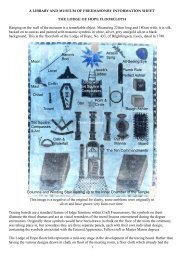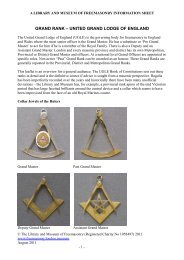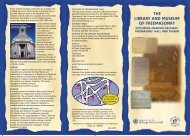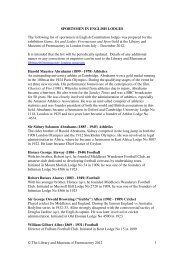1 A LIBRARY AND MUSEUM OF FREEMASONRY INFORMATION ...
1 A LIBRARY AND MUSEUM OF FREEMASONRY INFORMATION ...
1 A LIBRARY AND MUSEUM OF FREEMASONRY INFORMATION ...
You also want an ePaper? Increase the reach of your titles
YUMPU automatically turns print PDFs into web optimized ePapers that Google loves.
Other organisations have used banners to proclaim their identity. Trade Unions have used banners since<br />
at least the 1840s, carried in processions and May Day parades. Political organisations, temperance<br />
movements and the City Guilds have all used them. Today ad hoc banners are often carried in<br />
demonstrations.<br />
Here we see a procession of the “Scald Miserable Masons” in London in 1741, actually organised to mock and ridicule<br />
real Freemasons but nevertheless carrying banners marked with Masonic symbols.<br />
Lodges under the jurisdiction of the United Grand Lodge of England have their own individual insignia,<br />
a lodge badge, which many also display as a banner often carried in front of members as they march in<br />
procession. Such processions are rare now, but the banners still hang in masonic halls and lodge rooms<br />
across the country. In some lodges the master displayed his own coat of arms as a banner for his one<br />
year term of office.<br />
Grand Lodge itself has its own coat of arms. The Premier Grand Lodge, formed in 1717, adopted theirs<br />
from the London Company of Masons and were known to be using it by 1730. The Antients Grand<br />
Lodge claimed theirs came from the writings of a 17 th Century Jewish scholar, Rabbi Jacob Jehudah<br />
Leon, and adopted it at their foundation in 1751. Both were combined at the Union of the Grand<br />
Lodges in 1813 and form the basis of the current coat of arms, now with the addition of a red border<br />
with eight lions, indicative of the Arms of England, granted by the College of Arms in 1919 (see the<br />
information sheet “The Arms of the United Grand Lodge of England” for a more detailed history). The<br />
Grand Lodge also has its own banner, embroidered with this coat of arms, which can be seen hanging in<br />
the main gallery of the Library and Museum of Freemasonry together with the banner of the current<br />
Grand Master and previous Grand Masters who have held that office since 1901. These are heraldic,<br />
being the coats of arms of the person who held the position.<br />
Here, on the left, is the standard of the United Grand Lodge of England itself, bearing Grand Lodge’s<br />
Coat of Arms and, on the right, that of the current Grand Master, HRH Prince Edward the Duke of<br />
Kent (1935- ). When the Grand Lodge meets at Freemasons’ Hall both these standards are carried into<br />
the Grand Temple immediately behind the presiding officer.<br />
2










